symboom
International Hazard
    
Posts: 1143
Registered: 11-11-2010
Location: Wrongplanet
Member Is Offline
Mood: Doing science while it is still legal since 2010
|
|
Copper Peroxide
Copper Peroxide synthesis
Reagents needed
Copper sulfate
Ammonium hydroxide
Hydrogen peroxide
I have performed this reaction discoved this compound by accident was trying to form copper nitrite didnt work from the reaction of ammonia and
hydrogen peroxide but something interesting formed copper peroxide
Not sure how it compares to zinc peroxide
The procedure is here https://en.m.wikipedia.org/wiki/Copper_peroxide
I realized the strange percipitate was copper peroxide
When I saw the process to obtain copper peroxide was the same in what I did.
My procedure ammonium hydroxide is added to a copper sulfate solution till a percipirate forms then dissolves in excess ammonia solution forming
copper complex then it is chilled to just above freezing
A chilled solution also slightly above freezing point of 3 percent hydrogen peroxide once both solutions were chilled the hydrogen peroxide is added
to the copper complex a percipitate of copper peroxide is formed it is unstable in aqueous solution and must be filtered immediately and dried
Once the solution reaches room temperature you can see the precipitate start to disappear
This is a little tricky procedure once cold not too difficult
Percipitate does form fast.
Solutions are more stable when chilled near freezing
The percipitate disappears when it gets too warm
it reacts with water slowly.
Note from wikipedia
When wet, copper peroxide readily decomposes at temperatures above 6°C; it "is far more stable when dry".
Ive had it around dry very stable.
[Edited on 9-3-2017 by symboom]
|
|
|
PHILOU Zrealone
International Hazard
    
Posts: 2893
Registered: 20-5-2002
Location: Brussel
Member Is Offline
Mood: Bis-diazo-dinitro-hydroquinonic
|
|
What can it be useful for except very dangerous boosted thermite analog of the powerful explosive Al/CuO?
--> Al/CuO2?
Maybe as dangerous catalyst and oxygen carrier for unsensitive HE or Explosive compositions?
Do you have something else into mind?
[Edited on 9-3-2017 by PHILOU Zrealone]
PH Z (PHILOU Zrealone)
"Physic is all what never works; Chemistry is all what stinks and explodes!"-"Life that deadly disease, sexually transmitted."(W.Allen)
|
|
|
symboom
International Hazard
    
Posts: 1143
Registered: 11-11-2010
Location: Wrongplanet
Member Is Offline
Mood: Doing science while it is still legal since 2010
|
|
That was the first one I thought of first didnt bother trying it
Sugar and copper peroxide reaction
Copper peroxide substituted for chlorate
zinc and copper peroxide reaction
Is one reaction that comes to mind
Negative x
Modified composition
Interesting is if It could be added to make an energetic which is normally insensitive more sensitive to reactions I think I read where hydrogen
peroxide does this in some mixes
Have the synthysis down just need a use for it
[Edited on 10-3-2017 by symboom]
[Edited on 10-3-2017 by symboom]
|
|
|
Σldritch
Hazard to Others
  
Posts: 309
Registered: 22-3-2016
Member Is Offline
Mood: No Mood
|
|
I was trying to make copper peroxide too until i ran out of ammonia but i tried
reacting copper hydroxide with ice-cold hydrogen peroxide.
I just added the copper hydroxide to the hydrogen peroxide and immidetly vacuum filtered. I tried reacting it with sugar while it was still moist but
there was next to no reaction. It did give a yellow green streak when i tried too crush it and it was significantly harder then the starting copper
hydroxide similar too how sinc peroxide produced from zinc oxide also forms harder large chunks.
I was going to try mixing it with copper acetylide for that double copper goodness but it might be a bit too unstable.
EDIT: Found some ammonia and tried it. Please dont use 12% hydrogen peroxide or higher... Got a nice Foomphh and everything is everywhere. Im so
stupid.
[Edited on 10-3-2017 by Σldritch]
|
|
|
symboom
International Hazard
    
Posts: 1143
Registered: 11-11-2010
Location: Wrongplanet
Member Is Offline
Mood: Doing science while it is still legal since 2010
|
|
Cold cold cold or frozen im trying freezing both solutions to form a slush yes this is overkill but alot more forms
My best results were from freezing the tetraamine copper sulfate and the 3% hydrogen peroxide and breaking up the ice into an ice slush.
then mix see if I catch a glimpse of green copper peroxide as temperature increases and the reaction starts and then a little bubbling happens then
as it melts more the bubbling becomes more vigorous you with know it is cold enough because a green brown percipitate inly forms when the temperature
is low enough
The reaction melts the icefast the bubbles are from the copper peroxide decomposing althouth it seemed like it was the peroxide decomposing more
because the color did not seem to change filtering it is a terrable
it goes through coffee filters and some stays behind wow is copper peroxide sensitive to temperature turns from tetramine copper sulfate color to
dark green to brown this reaction would be great in the dead of a frozen winter
Sidenote concentrated peroxide is not really needed it may be worse because it reacts very fast although if you freeze it it might react slow enough
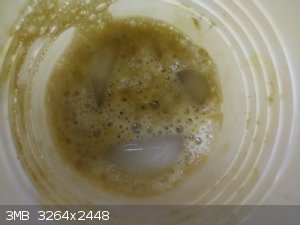
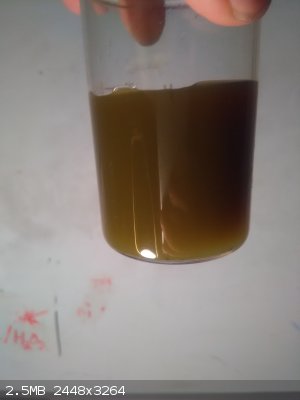 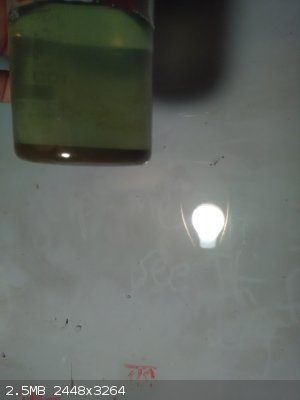
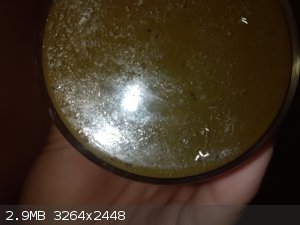 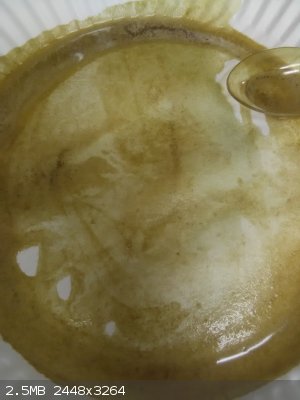
I hope these photos also help anyone trying this.
The color that is stated is hard to tell looks dark green and sometimes brown.
Was fine underwater for a day at room temperature
Definatly dark green it turned brown on the paper plate it seems no bubbles but it did seem to react due to color change dont let fully dry on paper
plate
Next is testing it decomposition temp
And mixing with a suitable fuel and aluminum and copper peroxide does not seam like a good Idea
I have zinc/titanium
Maybe try sugar or stronger deoxidizer vitamin c any suggestions I have around 2 grams
[Edited on 16-6-2017 by symboom]
[Edited on 16-6-2017 by symboom]
|
|
|
symboom
International Hazard
    
Posts: 1143
Registered: 11-11-2010
Location: Wrongplanet
Member Is Offline
Mood: Doing science while it is still legal since 2010
|
|
Defiantly works sensitive to heat releases lots of oxygen I should have made more this chemical is very interesting dark olive green dont let it dry
out on paper plate lost a lot of it
Its not extremely sensitive I still had some left the color can be confusing though it looks brown so at times I thought I ruined it
Sounds like chlorate heated a small sample and a whoosh sound is heared with the powder poping out as it is heated
This chemical might actually be a powerful oxidizer.
Looking forward to others reproducing this chemical
[Edited on 17-6-2017 by symboom]
[Edited on 17-6-2017 by symboom]
|
|
|
symboom
International Hazard
    
Posts: 1143
Registered: 11-11-2010
Location: Wrongplanet
Member Is Offline
Mood: Doing science while it is still legal since 2010
|
|
Sorry for the tripple post but I think I figured out a method that works urea peroxide adduct it seems to work although the problems 3% peroxide is so
dilute it works but so little product
And the more concentrated stuff bubbles alot it is annoying also need to try glow stick peroxide
|
|
|
Σldritch
Hazard to Others
  
Posts: 309
Registered: 22-3-2016
Member Is Offline
Mood: No Mood
|
|
Alright, my new hotplate broke so i had another go at copper peroxide or several and i managed to make a a very small amount.
It seems that the thing limiting yield most is the filtering since the precipitate from symbooms method is very small and clogs the filter.
Anyway acetone works great to dry it once the water is gone but do not be too hasty with it or the tetraamine copper sulfate will precipitate. Ill
update with copper acetylide later.
UPDATE:
1:1 Cu2C2:CuO2 is more brisant than Cu2C2 as one would expect. Much smaller fireball and does
not leave nearly as much soot/copper on paper as copper acetylide.
Both Copper Acetylide and 1:1 Copper Acetylide:Copper Peroxide were tried with 30mg on A4 paper.
I guess 1:1 Copper Acetylide:Copper Peroxide leaves less of a mark because all of the copper boils off and all of the carbon burns.
My ears hurt; i need to do 10mg next time...
[Edited on 10-7-2017 by Σldritch]
|
|
|
symboom
International Hazard
    
Posts: 1143
Registered: 11-11-2010
Location: Wrongplanet
Member Is Offline
Mood: Doing science while it is still legal since 2010
|
|
Yes I had the same problem I goes right through filter paper the one experiment where a serious filter is needed I was thinking of cardboard as a
filter material. so the slow filter paper size might help.
Problem: when making copper peroxide ultra fine filter paper is needed for copper peroxide maybe a hand centrifuge the solution does settle the top
liquid blue and the bottom green as the percipitate settles.
Should have taken pictures showing it degrading in water
Going from dark green to light green I wonder what is happening conversion to Cu2O copper 1 oxide?? Im glad to see others interested in copper
peroxide.
[Edited on 10-7-2017 by symboom]
|
|
|
Σldritch
Hazard to Others
  
Posts: 309
Registered: 22-3-2016
Member Is Offline
Mood: No Mood
|
|
I think it would be a better idea to make it from copper hydroxide, which supposedly yields microscopic crystals, and then wash it with ammonia to get
rid of the hydroxide/oxide impurities. Try making a fresh suspension from sodium hydroxide and copper sulfate. Ill try to make a reliable method
similar to that later.
EDIT: The red oxide is copper (III) oxide. It is more prevalent in caustic suspensions. It will form in hydrogen peroxide and sodium cuprite. Much
harder to isolate though i think since it needs a lot of base which is hard to get rid of due to viscosity, solubility and very low volatility
[Edited on 10-7-2017 by Σldritch]
|
|
|
PHILOU Zrealone
International Hazard
    
Posts: 2893
Registered: 20-5-2002
Location: Brussel
Member Is Offline
Mood: Bis-diazo-dinitro-hydroquinonic
|
|
Quote: Originally posted by symboom  | Yes I had the same problem I goes right through filter paper the one experiment where a serious filter is needed I was thinking of cardboard as a
filter material. so the slow filter paper size might help.
Problem: when making copper peroxide ultra fine filter paper is needed for copper peroxide maybe a hand centrifuge the solution does settle the top
liquid blue and the bottom green as the percipitate settles.
Should have taken pictures showing it degrading in water
Going from dark green to light green I wonder what is happening conversion to Cu2O copper 1 oxide?? Im glad to see others interested in copper
peroxide.
[Edited on 10-7-2017 by symboom] |
Add cold methanol for two first pre-wash/sedimentation and a final wash/sedimentation with cold ether afterwards.
Why?
The introduction of methanol or ether will:
1°) reduce the density of the solvent hence increasing the density difference between sediment and solvent what will lead to a faster sedimentation
speed.
2°) take rid of the water and allow for faster drying afterwards
Centrifuge is indeed most wanted if no filter paper is wished into the process...and to minimise the losses of ultra-fine precipitate particles.
What happens upon standing into water?
I don't think you'll get red Cu2O...only black/brown CuO should be forming.
What happens is probably the following:
Cupric oxyde or peroxyde hydrates to hydroxyde and generates some H2O2 and Cu(2+) aswel.
CuO (s) + H2O (l) <==> Cu(OH)2 (s)
Cu(OH)2 (s) <==water--> Cu(2+) + 2 OH(-)
CuO2 (s) + H2O (l) <==> Cu(OH)(OOH) (s)
Cu(OH)(OOH) (s) + H2O(l) <==> Cu(OH)2 (s) + H2O2 (l)
Cu(OH)(OOH) (s) <--==> Cu(OH)2 (s) + 1/2 O2 (g)
Those reactions are more than probable since CuO2 can be also prepared directly from CuO/H2O2 or Cu(OH)2/H2O2
Cu(2+) is known to decompose catalytically H2O2 into H2O and O2...
H2O2 <--Cu(2+)==> H2O + 1/2 O2
PH Z (PHILOU Zrealone)
"Physic is all what never works; Chemistry is all what stinks and explodes!"-"Life that deadly disease, sexually transmitted."(W.Allen)
|
|
|
PHILOU Zrealone
International Hazard
    
Posts: 2893
Registered: 20-5-2002
Location: Brussel
Member Is Offline
Mood: Bis-diazo-dinitro-hydroquinonic
|
|
Quote: Originally posted by Σldritch  |
UPDATE:
1:1 Cu2C2:CuO2 is more brisant than Cu2C2 as one would expect. Much smaller fireball and does
not leave nearly as much soot/copper on paper as copper acetylide.
Both Copper Acetylide and 1:1 Copper Acetylide:Copper Peroxide were tried with 30mg on A4 paper.
I guess 1:1 Copper Acetylide:Copper Peroxide leaves less of a mark because all of the copper boils off and all of the carbon burns.
My ears hurt; i need to do 10mg next time...
[Edited on 10-7-2017 by Σldritch] |
Some remarks...
1°) A tinier fireball would mean less power and lower heat of explosion...
2°)
MM CuO is 79,5 g/mol
MM CuO2 is 95,5 g/mol
MM Cu2C2 is 151.02 g/mol
Since the CuO2 is unpure...you have a mix of CuO (dead weight) and CuO2...
Thus with a 1/1 ratio by weight even if CuO2 was pure...you would be onto the negative OB side and "over-fueled".
3°)
Cu2C2 --> 2 Cu + 2 C + heat 1 (eq1)
Cu2C2 + 2 O --> 2 Cu + 2 CO + heat 2 (eq2)
Cu2C2 + 4 O --> 2 Cu + 2 CO2 + heat 3 (eq3)
Cu2C2 + 5 O --> Cu2O + 2 CO2 + heat 4 (eq 4)
Cu2C2 + 6 O --> 2 CuO + 2 CO2 + heat 5 (eq5)
Heats generated 5>4>3>2>1
CuO2 can only afword 1 oxygen atom and to fully burn Cu2C2 ... you must be into the conditions of eq3-eq4 or eq5.
Assuming pure CuO2 (otherwise following numbers must be even higher...) those equations means the following molar ratios Cu2C2/CuO2:
1/4 for eq3 (or 151,02 / 382 = 1/2,53 by weight)
1/5 for eq4 (or 151,02 / 477,5 = 1/3,162 bw)
1/6 for eq5 (or 151.02 / 573 = 1/3,794 bw)
Thus with a 1/1 ratio you are far from burning all the materials to gases and ashes...and your guess is thus simply wrong...
4°)
The boiling of Cu requires really a lot of heat (not reached here)...all the carbon can't burn because not overoxygenated mix...
The only explanation to observations are:
A) that the explosion is stronger...there is more heat and the gas expension propells the Cu dusts further (thus dilluting the spot)
B) that the flame is probably brighter and less yellow because more oxygen is available into the explosive stuff; thus the blast is faster and flame
remanence is lower to the eyes.
5°)
Use ear-protections caps if you want to preserve your auditive abilities...and not become prematurely deaf...
30mg into a closed room is not friendly to eardrums nor to hair-cells (thus very bad hair conditionning   ) )
6°)
The ultimate power mix is not a simple aftermath of the previously posted equations...and numbers...
Why?
Since you have to take into account the facts that:
a) Cu2C2 is a bad explosive primary - it contains a lot of dead weight (Cu is 84% of its mass) and it will be into the decomposition products as Cu,
Cu2O or CuO...this will be heated and thus take a big deal of the explosion energy.
b) CuO2 is a bad non-explosive/explosive (?) oxydiser - it contains also a lot of dead weight (Cu is 66,5% of its mass) and it will be into the
decomposition products as CuO (eventually Cu and CO if a lot of C is present)...this will be heated and, just like for the previous "a)" case, it will
take a big deal of the explosion energy.
What is the point?
By increasing the amount of CuO2 you shift to a better OB balance and thus you get more energy out of the fuel...but at the same time you reduce the
amount of fuel to put some oxydiser into the mix and you bring together a non negligible dead weight copper counterpart...This will be less critical
if CuO2 is explosive too...but stil a non negligible effect.
==> This means that there must be a sweet optimum blast energy spot to find by experimental trial/errors variation (by slight incréments) of the
mix ratio from 1/0,8 bw to 1/4 bw...
Would also be good to test for pure Cu2C2 and pure CuO2...for comparison purpose; and to check the purity of the CuO2 by titration of its available
oxygen...
The best tool for such a determination of the power would be sand crushing testing.
During all the testing...you would need to use the same sand, same basting device, the same detonating caps, the same quantities of tested material,
into the same geometric conformation and of course the same batches of Cu2C2 and CuO2...
PH Z (PHILOU Zrealone)
"Physic is all what never works; Chemistry is all what stinks and explodes!"-"Life that deadly disease, sexually transmitted."(W.Allen)
|
|
|
PHILOU Zrealone
International Hazard
    
Posts: 2893
Registered: 20-5-2002
Location: Brussel
Member Is Offline
Mood: Bis-diazo-dinitro-hydroquinonic
|
|
Quote: Originally posted by Σldritch  | I think it would be a better idea to make it from copper hydroxide, which supposedly yields microscopic crystals, and then wash it with ammonia to get
rid of the hydroxide/oxide impurities. Try making a fresh suspension from sodium hydroxide and copper sulfate. Ill try to make a reliable method
similar to that later.
EDIT: The red oxide is copper (III) oxide. It is more prevalent in caustic suspensions. It will form in hydrogen peroxide and sodium cuprite. Much
harder to isolate though i think since it needs a lot of base which is hard to get rid of due to viscosity, solubility and very low volatility
[Edited on 10-7-2017 by Σldritch] |
The use of CuO or Cu(OH)2 is probably better than the NH4OH route because it allows for the use of more concentrated H2O2 than 3%...like 33% (130
volumes) or 50% (200 volumes).
Would be nice to compare the 3 routes...and the purity of the resulting CuO2 on the basis of its (active) oxygen content...
PH Z (PHILOU Zrealone)
"Physic is all what never works; Chemistry is all what stinks and explodes!"-"Life that deadly disease, sexually transmitted."(W.Allen)
|
|
|
Σldritch
Hazard to Others
  
Posts: 309
Registered: 22-3-2016
Member Is Offline
Mood: No Mood
|
|
1):
From wiki:
Thermal decomposition of copper acetylide in vacuum is not explosive and leaves copper as a fine powder at the bottom of the flask, while depositing a
fluffy very fine carbon powder on the walls. On the basis of spectral data, this powder was claimed to be carbyne C(−C≡C−)nC rather than
graphite as expected.[2]
So from this i came to the conclusion that it is not the the decomposition of copper acetylide that is explosive but the burning of the finely divided
decomposition products. This is implied from the disproportionally large fireball from detonating copper acetylide.
A smaller fireball would mean more of the reaction products are burned earlier and coantrubutes more to the detonation.
2) and 3):
The negative OB was intended, i only had 15 mg of copper peroxide, and not being experienced with explosives thought i had to be conservative of it
and opted for a negative OB. Also the negative OB was intended to encoaurage copper formation. Ill admit that was a bad idea since obviously all the
copper would instantly burn...
4): Yes, most of the copper did probely not boil. Especially because it would require 3400C or there about to reverse its reaction with oxygen 
4A: Yes but its probely mostly soot that hit the paper and therefore lost
access to oxygen. (Ammonia gives it very little color)
4B: Not that it is a very exact measure but the flame looked a little
more yellow. Im going to guess this was the case.
5):
Yes i learned that very quickly, its my first time doing something like this. Sadly it means i cant compare the souand of the two explosions.
6): Ultimate power was never the goal.
Why? Why not? Its intresting, its fun and it is the coppererliest.
Thanks for the comments i guess, try making the copper (III) oxide. 
|
|
|
symboom
International Hazard
    
Posts: 1143
Registered: 11-11-2010
Location: Wrongplanet
Member Is Offline
Mood: Doing science while it is still legal since 2010
|
|
Interesting
The name peroxites has been suggested for the true salts of hydrogen peroxide drawing from the like chlorite to peroxite
there are two copper peroxides lower "peroxide" Cu2O3 and the higher one CuO2
According to sources copper peroxide can be dark green/ brown/yellow brown/ orange yellow / and red
1
At 0° C. neutral hydrogen peroxide converts cupric hydroxide into the brown copper peroxide.
2
It is also produced by the interaction of solutions of cupric chloride and hydrogen peroxide with alcoholic potash at -40c
3
an ether-solution of hydrogen peroxide. on very finely powdered cupric hydroxide at 0° C.
4
The compounds obtained by the action of hydrogen peroxide on cupric hydroxide forming a yellow, gelatinous peroxide of the formula CuO2. A solution of
sodium copper carbonate, Na2Cu(CO3)2, reacts with hydrogen peroxide to precipitate a very unstable, yellowish-brown peroxide, containing more oxygen
than would correspond with the formula Cu2O3, but less than that required by CuO2.
__________ _________ ______ _____
And here is the other peroxide Cu2O3
This copper peroxide, Cu2O3, is stated to be formed as an orange-yellow substance by electrolytic oxidation with a high current-density at a copper
anode immersed in concentrated caustic alkali, and hydrogen peroxide
also by the action of alkaline hypochlorite and hypobromite on cupric hydroxide and copper.
An example is the interaction of potassium persulphate with a mixture of cupric hydroxide and barium hydroxide cooled with ice and salt, colour
changes taking place in the solution, and a amaranth-red precipitate being deposited.
Properties of Cu2O3
The substance formed yields oxygen with sulphuric acid, liberates chlorine from hydrochloric acid, oxidizes ammonia in the cold to nitrogen and
nitrous acid and traces of nitric acid, decolorizes permanganate, and liberates iodine from potassium iodide.
Compare and contrasting
It is not a peroxide, since with dilute acids it does not yield hydrogen peroxide, and therefore differs from the orange-yellow pperoxide obtained by
means of hydrogen peroxide. The ratio between the percentages of copper and active oxygen present corresponds with the formula Cu2O3.
Excerpt and quotes from atomistry.com
My covering of copper and zinc peroxide
Copper peroxide on can use a weaker hydrogen peroxide solution compared to zinc peroxide due to copper hydroxide being unstable and zinc hydroxide is
more stable therefore zinc peroxide requires higher peroxide concentration for a more complete reaction or else it will be a mixture of zinc hydroxide
and zinc peroxide.
Zinc peroxide is more stable than copper peroxide which decomposes in water the copper ion decomposes peroxide
Hydrogen peroxide is stable in a suspension containing zinc ion
[Edited on 23-7-2017 by symboom]
|
|
|